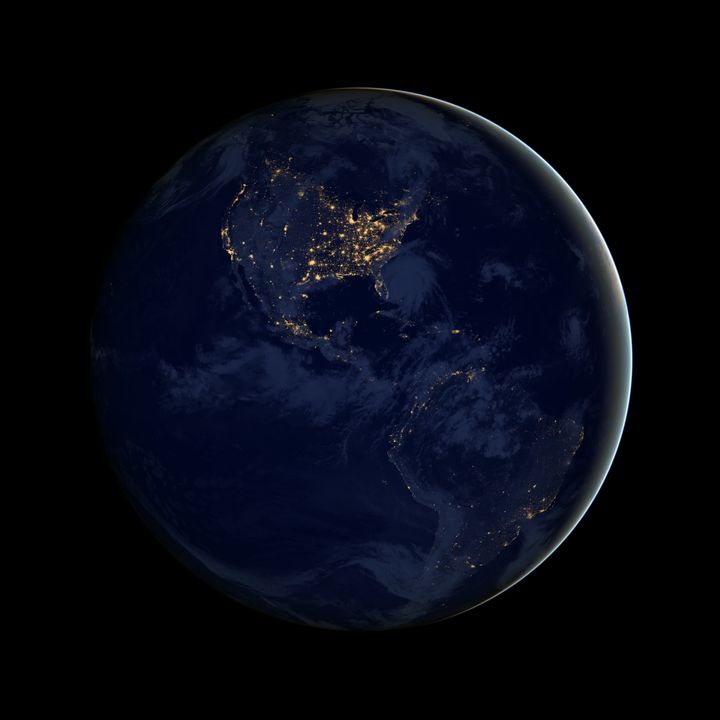
A composite image of North and South America at night assembled from data acquired by the Suomi NPP satellite in April and October 2012.
By Jesse Woodroffe and Michael Rivera
When the last really big solar storm hit Earth in 1921, the Sun ejected a burst of plasma and magnetic structures like Zeus hurling a thunderbolt from Mount Olympus. Earth’s magnetic field funneled a wave of electrically charged particles toward the ground, where they induced a current along telegraph lines and railroad tracks that set fire to telegraph offices and burned down train stations. As ghostly curtains of Northern Lights danced far south over the eastern United States, the fledgling electric grid flickered and went dark.
Almost a century later, today’s grid is bigger, more interconnected, and even more susceptible to a solar storm disaster. No one knows exactly how susceptible, but one recent peer-reviewed study found that an epic solar, or geomagnetic, storm could cost the United States more than $40 billion in damages and lost productivity.
Most geomagnetic storms are harmless. They regularly lash across Earth after a coronal mass ejection sprays electrons, protons, and other charged particles from the Sun. If they’re aimed just right, a few days later Earth’s magnetic field snares them. They accelerate and light up in another brilliant—and harmless—display of Northern Lights (or Southern Lights below the equator).
But the less frequent, more severe kind of space weather—call it a 100-year storm—can fry technology and cripple the energy infrastructure. In 1921, it was lights-out across town. Today, heavy dependence on electric-powered technology makes society more vulnerable. In a scant few minutes, a major storm could blow out key components in the electric grid across wide swathes of the United States. Cascading failures could wreak havoc on the water supply, life-saving medical activities, communications, the internet, air travel, and any other grid-dependent sector.
Mindful of the danger, the nation has developed a plan to support electric utilities in defending against these storms. As part of that plan, we’re researching the credible scenarios that could lead to large impacts. Los Alamos National Laboratory has been studying space weather for more than 50 years as part of our national security mission to monitor nuclear testing around the globe, and part of that work includes studying how the radiation-saturated environment of near space can affect technology and people.
Now Los Alamos is mining decades’ worth of data from a global network of ground-based geomagnetic sensors, running statistical analyses, and generating computer simulations that model the magnitude, electrical and magnetic characteristics, and location of geomagnetic storms. Just like thunderstorms, solar storms vary, from the orientation of their traveling magnetic field to the kind of particles hurtling our way. The data shows that weaker storms tend to flare up closer to the planet’s poles. In the Northern Hemisphere, stronger storms dip farther south, so they’re more likely to threaten population centers, such as New York City or Chicago. But our models predict that the biggest solar storms don’t necessarily cause the greatest damage—location can trump storm intensity.
Knowing what might happen, and where, is crucial for government and industry to assess the threats and weigh the risks. Then they can establish the procedures, practices, and regulations needed to withstand the worst solar storms. To support that work, Los Alamos will incorporate its space weather research into new software tools for suggesting industry investments in greater grid resilience and informing government requirements for utilities, such as where to site stations and what kind of transformers to install.
Space weather scientists have a saying: When you’ve seen one solar storm, you’ve seen one solar storm. The key to grid resilience is knowing something about all possible storms. Armed with scientific analysis from Los Alamos about how frequently a major geomagnetic storm might strike, which regions of the country are most vulnerable, and how bad it might be, electric utility companies and government regulators can take the necessary steps to spare us all from the nightmare of days, weeks, or even months without power. That way, we can all keep the lights on the next time the Sun decides to toss an extra few billion trillion trillion charged particles our way.
Jesse Woodroffe is a staff scientist who works on the Space Environment, Effects, and Mitigation team in the Space Science and Applications (ISR-1) group at Los Alamos National Laboratory. The group traces its origins to the Project Vela satellites, which ensured compliance with the 1963 Limited Test Ban Treaty by deploying some of the first measurements of Earth’s space radiation environment. Michael Rivera is a staff scientist who works in the Analytics, Intelligence and Technology Division's Information Systems and Modeling (A-1) group at Los Alamos National Laboratory.
